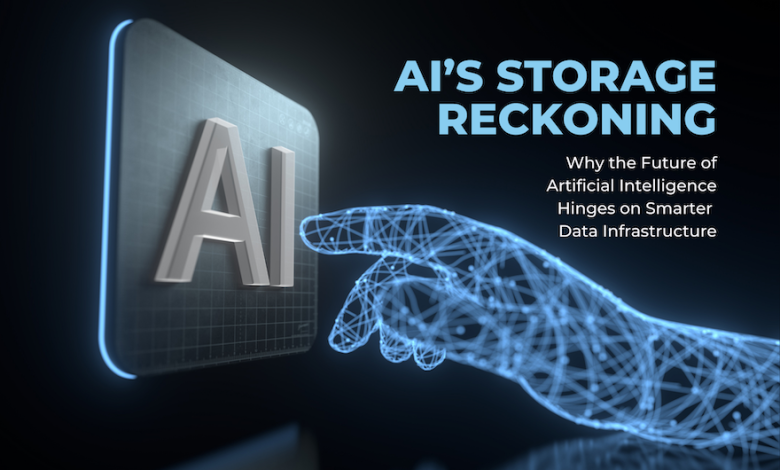
Artificial intelligence is often celebrated through the lens of its front-end breakthroughs — natural language systems approaching human fluency, medical imaging algorithms capable of spotting tumors earlier than radiologists, and autonomous platforms navigating cities with precision. Yet the true driver behind these advances lies not in the novelty of the algorithms, but in the sheer mass of data they consume and produce.
This hidden truth reveals a paradox: the more data AI systems ingest and generate, the more brittle and unsustainable the underlying infrastructure can become. Storage — often the least glamorous layer of the AI stack — is emerging as both a critical enabler and a looming constraint of progress.
Most industry narratives stop at GPUs and advanced compute. But it is storage that determines whether AI initiatives scale smoothly or collapse under their own weight. Unless addressed, today’s storage choices risk becoming tomorrow’s AI bottleneck.
Storage as AI’s Silent Accelerator — and Its Drag
Unlike conventional enterprise applications where data can sit idle for weeks or months, AI thrives on nonstop throughput. Training pipelines and inference clusters require a continuous diet of data delivered and collected at extreme velocity. In the case of retraining a large language model (LLM), these systems often run nonstop at full throttle for several months. This means the storage layers cannot rest; they must act less like an archive and more like a high-speed distribution system.
The outcome is predictable. Flash and disk systems remain powered and spinning around the clock, consuming energy whether or not the data is actively being used. The storage infrastructure in an AI data center behaves like a busy superhighway around the clock: congested, noisy, hot and energy intensive.
When Power, Not Silicon, Becomes the Gating Factor
For decades, progress in IT hinged on technical and financial barriers — chip density, cooling, bandwidth, capital expense. Today, the gating factor is increasingly electrical. Simply put: the power to operate and expand AI infrastructure is running into limits.
Consider Northern Virginia, Dublin, and other global data center hubs. Local grids are so strained that new data center construction is being deferred. The International Energy Agency projects that worldwide data center power use could triple by 2030, with AI as one of the principal contributors. At the same time, global electricity generation is projected to grow only about 2–3% annually (IEA, Electricity 2024). This alarming imbalance demands immediate action.
What’s often overlooked is that storage is a substantial part of this load. While GPUs are extremely power-intensive, the systems that stage, store, and serve up petabytes of training data are also relentless consumers.
Storage optimization — particularly moving cold AI data off power-intensive disk and flash and onto low-energy media such as magnetic tape — represents one of the most immediate and effective levers to keep AI growth sustainable.
The Cold Reality of AI Data
Ironically, most data being stored is cold — rarely, if ever, accessed. Studies suggest that 60–80% of enterprise data falls into this category (IDC; Leonovus; TDM). With respect to AI, this might include previous model versions, historical log files, simulation archives, backups, or compliance datasets that must be preserved for audit but play no active role in training or inference runs.
Despite their idleness, these datasets usually live on expensive, energy-intensive disk or flash arrays that stay fully powered 24/7. The result is an enormous “dark infrastructure cost” — money, space, and energy spent to maintain data that doesn’t need real-time performance.
Here lies the opportunity: in a world where energy is constrained and sustainability goals are non-negotiable, rethinking how cold AI data is stored is both an economic and environmental imperative.
The Coming Zettabyte Flood
The magnitude of this challenge is accelerating at a breathtaking rate. Training advanced models already requires datasets of multiple petabytes. But the growth curve is exponential, not linear. Every training cycle generates logs, refinements, and outputs that themselves become part of new datasets.
IDC forecasts that global data creation will surpass 291 zettabytes by 2027, with AI workloads as a major driver. At this scale, the question isn’t simply how to build larger data centers — it’s how to store and sustain this tidal wave without collapsing under the costs of energy, cooling, and floor space.
So far, most industry innovation has focused on GPUs, cooling technologies, and networking fabrics. The storage tier has remained largely conventional. Yet it is precisely at the storage layer where the easiest efficiency gains can be realized. By moving inactive or low-priority data off energy-intensive platforms and onto low-power alternatives, organizations can relieve pressure on both budgets and electrical grids.
Tape’s Modern Role in the AI Era
This is precisely why magnetic tape is regaining strategic importance.
Tape has been trusted for decades, but the technology has advanced far beyond its legacy roots. Modern tape systems offer astonishing data density, resilience, and — most importantly — energy efficiency unattainable by disk or flash. Unlike spinning media or solid-state, tape consumes virtually no power when idle. Data is written to a cartridge and waits offline until recalled. The difference is dramatic: tape can lower energy consumption by as much as 87% compared to disk for long-term retention. Another advantage for AI is that leading enterprise tape libraries provide enormous scalability, to multiple exabytes — a capability unmatched by any other on-premises storage system.
For AI, this means historical training data, compliance archives, and unused model versions can be shifted to tape, freeing expensive, resource-intensive primary storage for active workflows. This not only reduces operational cost but also extends the effective capacity of the AI environment without requiring new data center builds.
Crucially, tape no longer lives in isolation. Today’s libraries integrate seamlessly into cloud and AI infrastructure through object storage interfaces that are compatible with the Amazon S3 API. Tape innovators are aggressively advancing their technologies in lockstep with AI’s explosive data appetite. Breakthroughs in tape technology — most recently LTO-10 — now deliver up to 30 TB native capacity per cartridge, with more advancements on the horizon.
Beyond Algorithms: Smarter Systems for Smarter AI
As organizations pursue AI at scale, the focus cannot remain solely on developing smarter models. It must also include extensible and highly efficient infrastructure. Compute clusters may deliver the intelligence, but storage architectures will have a decisive influence on the economics, sustainability, and ultimately the viability of AI deployments.
Tape offers a unique balance of cost, scale, and environmental benefit that no other medium can match. Long valued for backup and compliance, tape is now proving indispensable for the sustainability of AI itself.
The New Mandate for IT Leaders
For CIOs, data center architects, and AI program managers, the mandate is clear: don’t let storage become the weak link. In a world where power is finite, regulations are tightening, and data is multiplying at zettabyte scale, storage strategies must evolve.
Cold data doesn’t belong on systems that burn power 24/7. Tiered storage architectures that actively incorporate tape can align infrastructure with both economic and ESG realities. By embracing these approaches, enterprises can protect themselves against spiraling costs, regulatory penalties, and stalled AI growth.
The future of AI will be shaped not only by what algorithms can achieve, but also by where and how their data lives. In an age where data is infinite, but energy is not, storage must move from an afterthought to center stage.
In summary
AI’s breakthroughs will continue to make headlines. But its storage reckoning is already here. Those who address it now — with intelligent, massively scalable, and power-aware infrastructure strategies — will be the ones who sustain competitive advantage in the AI era.



